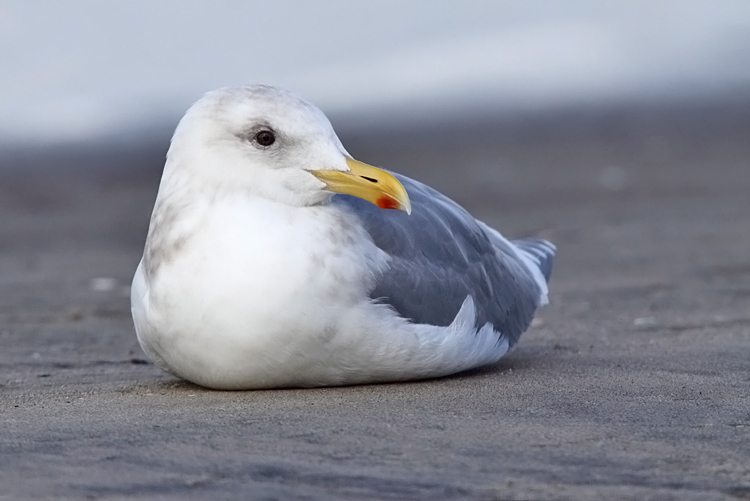
Location: Mission Bay, San Diego, CA
Date: 2009-02-07
Lens: Canon 600mm IS F4 + 1.4x II Converter

 Glaucous-Winged Gull
Larus glaucescens
Glaucous-Winged Gull
Larus glaucescens
 Description
DescriptionThe Glaucous-winged Gull hybridizes extensively with the Western Gull. The hybrids can appear similar to the adult parent forms, but with intermediate back and wingtip coloring. The Glaucous-winged gull feeds on a variety of food, including live animals, carrion, and garbage. This bird has been known to kill and eat rabbits, pigeons, and other Glaucous-winged Gull chicks.
General: Sexes similar. 20 to 23 inches in length.
Adult Alternate: White head, neck, breast, belly, and tail. Yellow bill with red spot near tip of lower mandible. Dark to dirty-yellow eyes. Pinkish orbital ring. Pale gray mantle. Pale gray primaries with white tips. White tertial crescent. Pink legs.
Adult Basic: Similar to adult alternate, but with blurry brown streaking and spotting on the head and nape.
First-Year Juvenile: Pale brown body plumage, including tail and primaries, which do not contrast with body plumage. Black bill. Dirty pinkish legs.
Second-Year Juvenile: Pale brown head, neck, upper breast, belly, primaries and tail. Black bill with pinkish base. Pale gray back. Pink legs.
Third-Year Juvenile: Similar to adult basic, but often lacks adult bill and wing pattern.
Rocky islands, coastal cliffs, beaches, dumps, fields, and parking lots.
 Nesting
Nesting1-4 lignt greenish eggs with dark markings. The eggs have a 27-29 day incubation period. Fledging occurs in 35-54 days. The nest is a scrape in the ground filled with grass, weeds, moss, roots, dead twigs, string, bones, turf, and/or seaweed. Nests in colonies, often with other gull species.